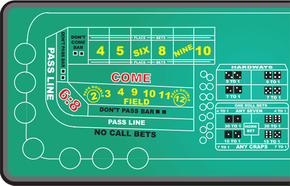Craps Basics: Pass/Don't Pass Bets
The long, curving section along the edge of the table closest to where the players stand is called the Pass Line.
"Pass Line" Bets
The most basic craps bet is the Pass Line bet. When you place a Pass Line bet, you're betting with the dice. In other words, you're betting that the either a 7 or an 11 will be the first number rolled (called the "come out" roll). If this happens, you double your money right away. If a 4, 5, 6, 8, 9, or 10 is rolled, this establishes a "point." When a point is set, you want that number to be rolled again, before a 7 is rolled (when the shooter "sevens out"). If the shooter rolls the point before he rolls a 7, you double your money.
Advertisement
If the number rolled on the come out roll is a 2, 3, or 12 (called Craps), you lose. If, after a point is established, a 7 is rolled before the point number is rolled again, you also lose.
"Don't Pass" Bets
Placing a Pass Line bet is betting with the dice, and placing a Don't Pass bet is betting against the dice. Pass Line bets are also said to be "betting right," while Don't Pass bets are said to be "betting wrong." (Not that either is any better or worse a bet than the other -- this is just craps jargon.) Don't Pass bets are just the opposite of Pass Line bets. Rather than hoping for a 7 or an 11 on the come out roll, you're hoping for a 2, 3, or 12 (the losing roll of Pass Line bets). A 2, 3, or 12 will double your money on a come out roll if you've placed a Don't Pass bet. When a point is established, rather than hoping that the point number will be rolled again before the 7 shows up, you're hoping that the point won't be rolled again before the 7 shows up -- if the 7 comes first, you win.
